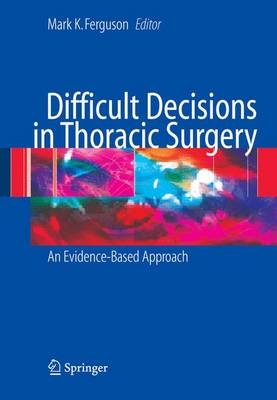
Difficult Decisions in Thoracic Surgery
Springer London Ltd (Verlag)
978-1-84996-593-4 (ISBN)
- Keine Verlagsinformationen verfügbar
- Artikel merken
BACKGROUND: Introduction.- Evidence-Based Medicine: Levels of Evidence and Grades of Recommendation.- Decision Analytic Techniques.- Non-Clinical Components of Surgical Decision Making.- How Patients Make Decisions with their Surgeons: The Role of Counseling and Patient Decision Aids.- LUNG: Radiographic Staging of Lung Cancer: Computed Tomography (CT) and Positron Emission Tomography (PET) .- Routine Mediastinoscopy for Clinical Stage I Lung Cancer.- Management of Unexpected N2 Disease Discovered at Thoracotomy.- Induction Therapy for Clinical Stage I Lung Cancer.- Induction Therapy for Stage IIIA (N2) Lung Cancer.- Adjuvant postoperative therapy for completely resected stage I lung cancer.- Sleeve Lobectomy vs. Pneumonectomy for Lung Cancer Patients with Good Pulmonary Function.- Lesser Resection Versus Lobectomy for Stage I Lung Cancer in Patients with Good Pulmonary Function.-. Lesser Resection vs RT for Patients with Compromised Lung Function and STAGE I Lung Cancer.- Resection for Patients Initially Diagnosed with N3 Lung Cancer after Response to Induction Therapy.- VATS Major Lung Resections.- Surgery for Non-Small Cell Lung Cancer with Solitary M1 Disease.- Thoracoscopy Versus the Open Approach for Resection of Solitary Pulmonary Metastases.- Unilateral or bilateral approach for unilateral pulmonary metastatic disease.- Surgery for Bronchoalveolar Lung Cancer.- LVRS in the Candidate for Lung Transplantation.- Pleural Sclerosis for the Management of Initial Pneumothorax.- ESOPHAGUS: Staging for Esophageal Cancer: PET, EUS.- Induction Therapy for Resectable Esophageal Cancer.- Transthoracic versus Transhiatal Resection for Carcinoma of the Esophagus.- Minimally Invasive vs Open Esophagectomy for Cancer.- Lymph Node Dissection for Carcinoma of the Esophagus.- Intrathoracic vs Cervical Anastomosis in Esophageal Replacement.- Jejunostomy after Esophagectomy.- Gastric Emptying Procedures after Esophagectomy.- Posterior Mediastinal or Retrosternal Reconstruction Following Esophagectomy for Cancer.- Postoperative adjuvant therapy for completely resected esophageal cancer.- Celiac Lymph Nodes and Esophageal Cancer.- Partial or Total Fundoplication for GERD in the Presence of Impaired Esophageal Motility.- Botox, Balloon or Myotomy: Optimal treatment for Achalasia.- Fundoplication after Laparoscopic Myotomy for Achalasia.- Primary Repair for Delayed Recognition of Esophageal Perforation.- Lengthening Gastroplasty for Managing GERD and Stricture.- Lengthening Gastroplasty for Managing Giant Paraesophageal Hernia.- Evidenced-Based Management of Zenker's Diverticulum: Open Versus Transoral Approaches.- Management of Minimally Symptomatic Pulsion Diverticula of the Esophagus.- DIAPHRAGM: Giant Paraesophageal Hernia: Thoracic, Open Abdominal, or Laparoscopic Approach.- Management of Minimaly Symptomatic Giant Paraesophageal Hernias.- Plication for Diaphragmatic Eventration.- Pacing for Unilateral Diaphragm Paralysis.- Optimal Crural Closure Techniques for Repair of Large Hiatal Hernias.- Management of Acute Diaphragmatic Rupture: Thoracotomy versus Laparotomy.- AIRWAY: Stenting for Benign Airway Obstruction.- Tracheal Resection for Thyroid or Esophageal Cancer.- PLEURA AND PLEURAL SPACE: Pleural Sclerosis for Malignant Pleural Effusion: Optimal Sclerosing Agent.- Management of Malignant Pleural Effusion: Sclerosis or Chronic Tube drainage.- Initial Spontaneous Pneumothorax: The Role of Thoracoscopic Therapy.- Intrapleural Fibrinolytics.- Diffuse Malignant Pleural Mesothelioma: The Role of Pleurectomy.- Treatment of Malignant Pleural Mesothelioma: Is There a Benefit to Pleuropneumonectomy?.- MEDIASTINUM: Management of Myasthenia Gravis: Does Thymectomy Provide Benefit over Medical Therapy.- Thymectomy for Myathenias Gravis.- Management of Residual Disease after Therapy for Mediastinal Germ Cell Tumor and Normal Serum Markers.- Management of Malignant Pericardial Effusions.- Asymptomatic Pericardial Cyst: Observe or Resect.- CHEST WALL: Optimal Approach to TOS: Transaxillary, Supraclavicular, or Infraclavicular.- Pectus Excavatum in Adults.
| Erscheint lt. Verlag | 13.10.2010 |
|---|---|
| Zusatzinfo | 37 black & white illustrations, 110 black & white tables |
| Verlagsort | England |
| Sprache | englisch |
| Maße | 178 x 254 mm |
| Gewicht | 1020 g |
| Einbandart | Paperback |
| Themenwelt | Medizinische Fachgebiete ► Chirurgie ► Herz- / Thorax- / Gefäßchirurgie |
| ISBN-10 | 1-84996-593-5 / 1849965935 |
| ISBN-13 | 978-1-84996-593-4 / 9781849965934 |
| Zustand | Neuware |
| Informationen gemäß Produktsicherheitsverordnung (GPSR) | |
| Haben Sie eine Frage zum Produkt? |
aus dem Bereich


